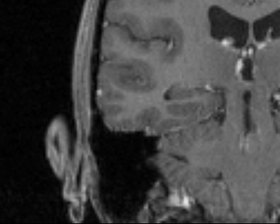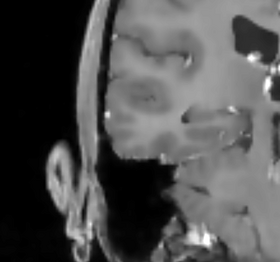Modules:GradientAnisotropicFilter-Documentation-3.6
Return to Slicer 3.6 Documentation
Module Name
Gradient Anisotropic Filter
General Information
Module Type & Category
Type: CLI
Category: Filtering/Denoising
Authors, Collaborators & Contact
- Author: Bill Lorensen
- Contact: bill.lorensen at gmail.com
Module Description
Runs gradient anisotropic diffusion on a volume.
Anisotropic diffusion methods reduce noise (or unwanted detail) in images while preserving specific image features, like edges. For many applications, there is an assumption that light-dark transitions (edges) are interesting. Standard isotropic diffusion methods move and blur light-dark boundaries. Anisotropic diffusion methods are formulated to specifically preserve edges. The conductance term for this implementation is a function of the gradient magnitude of the image at each point, reducing the strength of diffusion at edges. The numerical implementation of this equation is similar to that described in the Perona-Malik paper, but uses a more robust technique for gradient magnitude estimation and has been generalized to N-dimensions.
Usage
GradientAnisotropicDiffusion [--returnparameterfile
<std::string>]
[--processinformationaddress
<std::string>] [--xml] [--echo]
[--timeStep <double>] [--iterations
<int>] [--conductance <double>]
[--] [--version] [-h] <std::string>
<std::string>
Where:
--returnparameterfile <std::string>
Filename in which to write simple return parameters (int, float,
int-vector, etc.) as opposed to bulk return parameters (image,
geometry, transform, measurement, table).
--processinformationaddress <std::string>
Address of a structure to store process information (progress, abort,
etc.). (default: 0)
--xml
Produce xml description of command line arguments (default: 0)
--echo
Echo the command line arguments (default: 0)
--timeStep <double>
The time step depends on the dimensionality of the image. In Slicer3
the images are 3D and the default (.0625) time step will provide a
stable solution. (default: 0.0625)
--iterations <int>
The more iterations, the more smoothing. Each iteration takes the same
amount of time. If it takes 10 seconds for one iteration, then it will
take 100 seconds for 10 iterations. Note that the conductance controls
how much each iteration smooths across edges. (default: 5)
--conductance <double>
Conductance controls the sensitivity of the conductance term. As a
general rule, the lower the value, the more strongly the filter
preserves edges. A high value will cause diffusion (smoothing) across
edges. Note that the number of iterations controls how much smoothing
is done within regions bounded by edges. (default: 1)
--, --ignore_rest
Ignores the rest of the labeled arguments following this flag.
--version
Displays version information and exits.
-h, --help
Displays usage information and exits.
<std::string>
(required) Input volume to be filtered
<std::string>
(required) Output filtered
Development
Source code & documentation
Source Code: GradientAnisotropicDiffusion.cxx
XML Description: GradientAnisotropicDiffusion.xml
More Information
Acknowledgment
This work is part of the National Alliance for Medical Image Computing (NAMIC), funded by the National Institutes of Health through the NIH Roadmap for Medical Research, Grant U54 EB005149. Information on the National Centers for Biomedical Computing can be obtained from National Centers for Biomedical Computing.



